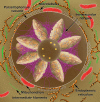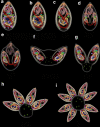The life-cycle of Toxoplasma gondii reviewed using animations
- PMID: 33228743
- PMCID: PMC7686686
- DOI: 10.1186/s13071-020-04445-z
The life-cycle of Toxoplasma gondii reviewed using animations
Abstract
Toxoplasma gondii is a protozoan parasite that is the causative agent of toxoplasmosis, an infection with high prevalence worldwide. Most of the infected individuals are either asymptomatic or have mild symptoms, but T. gondii can cause severe neurologic damage and even death of the fetus when acquired during pregnancy. It is also a serious condition in immunodeficient patients. The life-cycle of T. gondii is complex, with more than one infective form and several transmission pathways. In two animated videos, we describe the main aspects of this cycle, raising questions about poorly or unknown issues of T. gondii biology. Original plates, based on electron microscope observations, are also available for teachers, students and researchers. The main goal of this review is to provide a source of learning on the fundamental aspects of T. gondii biology to students and teachers contributing for better knowledge and control on this important parasite, and unique cell model. In addition, drawings and videos point to still unclear aspects of T. gondii lytic cycle that may stimulate further studies.
Keywords: Apicomplexa; Cell biology; Life-cycle; Parasite; Parasitology; Protozoology; Toxoplasmosis.
Conflict of interest statement
The authors declare that they have no competing interests.
Figures









Similar articles
-
Lytic cycle of Toxoplasma gondii.Microbiol Mol Biol Rev. 2000 Sep;64(3):607-23. doi: 10.1128/MMBR.64.3.607-623.2000. Microbiol Mol Biol Rev. 2000. PMID: 10974128 Free PMC article. Review.
-
[Toxoplasma gondii: a potential role in the genesis of psychiatric disorders].Encephale. 2013 Feb;39(1):38-43. doi: 10.1016/j.encep.2012.06.014. Epub 2012 Aug 21. Encephale. 2013. PMID: 23095600 Review. French.
-
Foodborne transmission of Toxoplasma gondii infection in the last decade. An overview.Res Vet Sci. 2021 Mar;135:371-385. doi: 10.1016/j.rvsc.2020.10.019. Epub 2020 Oct 24. Res Vet Sci. 2021. PMID: 33148402 Review.
-
Lytic Cycle of Toxoplasma gondii: 15 Years Later.Annu Rev Microbiol. 2015;69:463-85. doi: 10.1146/annurev-micro-091014-104100. Epub 2015 Aug 28. Annu Rev Microbiol. 2015. PMID: 26332089 Free PMC article. Review.
-
Long-Term Relationships: the Complicated Interplay between the Host and the Developmental Stages of Toxoplasma gondii during Acute and Chronic Infections.Microbiol Mol Biol Rev. 2015 Dec;79(4):387-401. doi: 10.1128/MMBR.00027-15. Microbiol Mol Biol Rev. 2015. PMID: 26335719 Free PMC article. Review.
Cited by
-
Oxidative Stress as a Possible Target in the Treatment of Toxoplasmosis: Perspectives and Ambiguities.Int J Mol Sci. 2021 May 27;22(11):5705. doi: 10.3390/ijms22115705. Int J Mol Sci. 2021. PMID: 34071892 Free PMC article. Review.
-
Development and evaluation of indirect enzyme-linked immunosorbent assay using recombinant dense granule antigen 7 protein for the detection of Toxoplasma gondii infection in cats in Thailand.Vet World. 2022 Mar;15(3):602-610. doi: 10.14202/vetworld.2022.602-610. Epub 2022 Mar 12. Vet World. 2022. PMID: 35497967 Free PMC article.
-
Comparison of Direct and Indirect Detection of Toxoplasma gondii in Ovine Using Real-Time PCR, Serological and Histological Techniques.Animals (Basel). 2024 May 10;14(10):1432. doi: 10.3390/ani14101432. Animals (Basel). 2024. PMID: 38791651 Free PMC article.
-
Social context influences Toxoplasma gondii and Trichinella spp. infection in Alberta free-roaming wild pigs (Sus scrofa).PLoS One. 2025 May 23;20(5):e0324617. doi: 10.1371/journal.pone.0324617. eCollection 2025. PLoS One. 2025. PMID: 40408391 Free PMC article.
-
The Trivalent Recombinant Chimeric Proteins Containing Immunodominant Fragments of Toxoplasma gondii SAG1 and SAG2 Antigens in Their Core-A Good Diagnostic Tool for Detecting IgG Antibodies in Human Serum Samples.Int J Mol Sci. 2025 Jun 12;26(12):5621. doi: 10.3390/ijms26125621. Int J Mol Sci. 2025. PMID: 40565085 Free PMC article.
References
-
- CDC. Toxoplasmosis - epidemiology & risk factors. Atlanta: Centers for Disease Control and Prevention; 2018. https://www.cdc.gov/parasites/toxoplasmosis/epi.html. Accessed 06 Aug 2020.
Publication types
MeSH terms
LinkOut - more resources
Full Text Sources
Other Literature Sources

